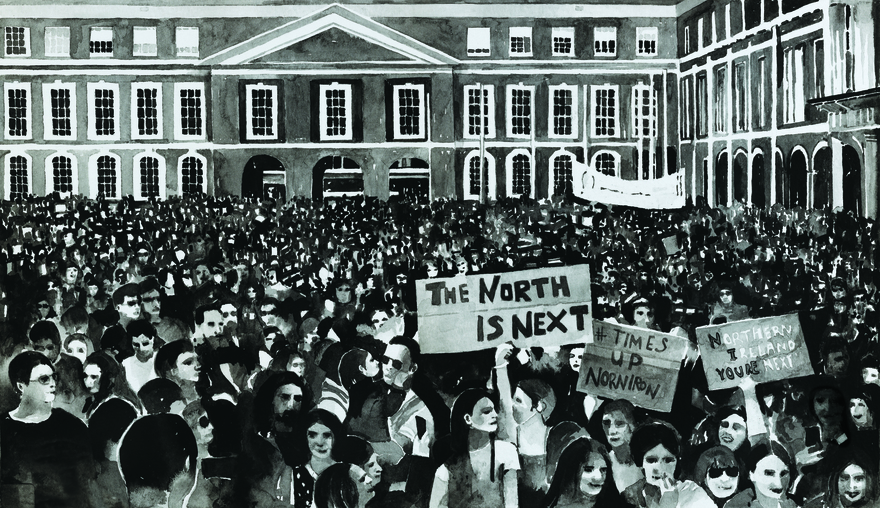Ormston House in the heart of Limerick City
Ormston House is a meeting place for the arts in the heart of Limerick City, Ireland. First opened in 2011 as a Cultural Resource Centre to welcome audiences seeking more maverick and experimental projects. However, recent history has come fringed with obstacles, as the organisation may face losing their space as the property was unexpectedly put on the open market. In the summer of 2018, following a tweet displaying the window sign advertising the space as for sale, the already crucial part of Limerick's cultural and social life gained great support off and online – sparking new hope for the space’s future. We spoke to Niamh Brown, the Co-Director of Ormston House about the threat to the space, future plans and of course this year’s Supermarket.
For SUPERMARKET 2019, Ormston House present works by Joy Gerrard. Drawing on themes of protest and urban space, Gerrard remakes media-borne crowd images from around the world. Recent work documents Brexit protests in the UK and the Repeal the 8th movement in Ireland.
2018 was a particularly difficult year for Ormston House. Would you say that you entered survival mode at some point during that turbulent period? Has it affected your work in any way?
2018 was a difficult year, but it was great to see the situation become part of the public discourse and create an urgency in securing our home, both with citizens and public figures alike. We have been working on long-term tenancy since 2015 and it can be disheartening to have the situation drag on. What has kept us going is the incredible outpouring of support from the local communities in Limerick and further afield. Having that kind of validation means so much to a small grassroots organisation.
I don’t know if we would call it ‘survival mode’, we had already been quietly working towards solutions for almost a year, but last summer it became very public. There is an element of self-care needed in those situations, we were very aware of that and (as always) needed to support each other as a team. We also have a responsibility to the artists and communities we work with and we had to make sure they felt supported by us.
Has it changed your approach to future projects?
Our tenancy situation has changed our approach to projects in the short-term. Until our tenancy has been resolved we are focusing on the professional development and training aspect to our programme, as well as international projects. During this time, we will not be running an exhibition programme and are only hosting a small number of one-off events. This will allow us to focus on securing long-term tenancy, which is key for our future sustainability.
What are you most looking forward to at Supermarket 2019?
We are most looking forward to working with Joy Gerrard for Supermarket this year. She is an incredible Irish artist, who has been documenting and recreating protest crowds from key global events for the last number of years. We will be showing new and archival works with a focus on Brexit protests and marches during the campaign for abortion rights in Ireland. Both are hugely relevant and important issues globally, but especially for Ireland.
We are also just looking forward to being back at Supermarket in 2019! We really missed it last year – it has become such important part of our calendar.
Given your recent experience, do you think that Supermarket, as an artist-run intersection, can help bridge some of the financial hardships that many of our exhibitors face? For example by facilitating new contacts and possibilities for international collaborations?
That is a good question and I think every exhibitor would have a different answer. We have certainly made incredible connections through Supermarket and look forward to making more. Supermarket Meetings can be a great place to discuss funding opportunities in other countries and gain advice from other organisations who have gone through similar struggles. Depending on the funding structures in each country, international collaborations can be difficult to realise. Public funding rarely covers the full cost of projects and artist-run initiatives seldom have the reserves to fund that type of activity. Personally, I think that real collaborations form better over time, and with a longer period of time dedicated to new projects it can be easier to apply for funding to cover costs.
Supermarket 2019 revolves around the theme of ’Temporary Moratorium’ and subjects shrouded in taboo. What do you see as controversial or taboo in contemporary art? Perhaps even forbidden?
That is a big question! I think every artist and arts worker will answer differently depending on their own beliefs and/or background. It also depends on ethics, as well as the social and political views of individuals and countries.
Leading up to the abortion rights referendum in Ireland last year, some artists and arts organisations felt that their voices could not be heard or they had to remain neutral or silent on the subject. This questioned not only the role of art during political and social movements in Ireland, but also highlighted the possibility of censorship and threats to those in receipt of public funding. This was a hugely emotive and divisive issue in Ireland, and for some, making art about abortion and bodily autonomy was taboo.
Follow Ormston House on their website here, on social media here and here... and of course see them live at Supermarket 2019 if you get the chance!



